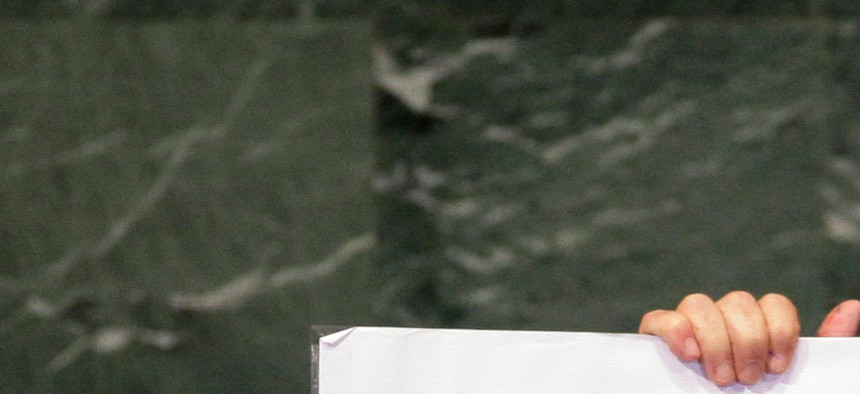
Israel's Prime Minister, Bibi Netanyahu, speaking at the 2012 United Nations General Assembly Richard Drew/AP
Don't Look Now, But the Iran Deal Is Working
Don’t look now – but Iran is complying, erasing Bibi’s cartoon bomb, and making even Gen. David Petraeus a believer. By Joe Cirincione
In September 2012, Israeli Prime Minister Benjamin Netanyahu stood at a United Nation’s podium with a cartoon bomb warning that the world had to stop Iran before it completed “the second stage of nuclear enrichment necessary to make a bomb.”
The prime minister can rest a bit easier now. We have stopped Iran from completing that second stage.
There are other ways that Iran could get a bomb. There are plenty of risks ahead as world powers hammer out a deal to constrain its nuclear program. But this particular threat is gone. Iran will not creep up to the threshold of bomb by making near-bomb-grade material. That threat is terminated. Or as John Cleese said about the parrot he tried to return to the Monty Python pet shop, “It is stone dead. It is definitely deceased. It’s bleeding demised. It is no more. It has ceased to be!”
The International Atomic Energy Agency, or IAEA, confirmed last week that Iran had effectively eliminated that “second stage” of uranium enrichment, as required by the interim deal negotiated between Iran and the United States, United Kingdom, France, Germany, Russia and China. And news reports over the weekend hinted that a second path to the bomb may be blocked as well. But first things, first.
Netenyahu’s cartoon stunt was strange but effective. With a diagram that could have been drawn by Wile E. Coyote, Netanyahu accurately summed up the threat and garnered front page photos in nearly every major world newspaper. In order for Iran to build a bomb, he said, it first had to go through three stages of uranium production:
The first stage: they have to enrich enough of low enriched uranium (3 to 5 percent enriched uranium).
The second stage: they have to enrich enough medium enriched uranium (20 percent).
And the third and final stage: they have to enrich enough high enriched uranium for the first bomb (90 percent).
Netanyahu warned that we had to draw a red line, which he dramatically did on his cartoon bomb, in between the final and second stages. We could not allow Iran to get to the point “where it’s a few months way or a few weeks away from amassing enough enriched uranium to make a nuclear weapon.”
The reason is that 20 percent uranium can be fed back into Iran’s centrifuges and rapidly turned into bomb-grade. One of America’s leading experts on Iran’s nuclear program, Greg Thielman of the Arms Control Association, explained in 2012: By the time Iran acquires approximately 225 kilograms of uranium gas…enriched to this level, it would be within one month of being able to further enrich to the 90 percent required for producing the metallic core of a nuclear warhead – assuming it takes 25 kilograms of material for one bomb.
When Netanyahu spoke, Iran had roughly 190 kilograms of medium enriched uranium and was making more every week. “That’s why I speak today with such a sense of urgency,” he said, “And why everyone should have a sense of urgency.” He predicted Iran would cross his red line by the summer of 2013.
It did not. When Hassan Rouhani became president of Iran in June 2013, he stopped expanding Iran’s uranium enrichment capability. The interim deal the U.S. and other nations secured with Iran last November rolled it back, directly addressing Netanyahu’s main fear. Iran agreed not only to stop enriching uranium to 20 percent, but to get rid of all it had made.
That goal has now been effectively reached. The IAEA report last week confirms that Iran cut its stock of medium enriched uranium by three-quarters. It has completely diluted half its stock down to low enriched uranium, and it has converted half of the remaining amount into reactor fuel, all ahead of schedule. It would be extraordinarily difficult and time-consuming to reverse these processes.
In short, Netanyahu’s bomb has been drained. His red line has been implemented. Even if Iran were to break the deal today, it would take it many months to make enough uranium for one bomb, and the world would see them doing it. Nor is there any indication that Iran is about to break off negotiations. In fact, the prospect that negotiators can work out a final agreement “now may be better than 50-50,” said David Petraeus, former CIA director and former U.S. Central Command commander, “which is not something we would have said even a few weeks ago, much less months ago.” According to Think Progress, Petraeus said at a talk at Harvard University, “I’m actually starting to believe that an agreement is possible and it could be that it’s possible before this particular six-month deadline expires,” referring to the target of concluding an agreement by July 20.
More potentially encouraging news came with comments April 19 by a senior Iranian official that the negotiators had “virtually resolved” the issue of Iran’s production of plutonium, another material that can be used in a nuclear bomb. Iran appears ready to redesign its controversial Arak research reactor in such a way that it could still produce radioactive isotopes for medical and other purposes, but not significant quantities of plutonium.
Scientists Frank von Hippel, Alexander Glaser and Zia Mian just last month published alternative designs that could assure that Iran could not quickly make plutonium for a bomb from the reactor. It may be that Iran has now agreed to such plans. Details on this and other technical issues will be worked out when experts from the seven negotiating states meet in New York on May 5.
This progress, though, does not appear to satisfy some. Sen. Robert Menendez, D-N.J., criticized Secretary of State John Kerry at a Senate hearing last week for seeking a final agreement that “only” ensured that it would take Iran at least six to 12 months to make the material for one bomb – even though that is much more that Netanyahu seemed to hope for two years ago. Some Israeli officials have moved their red line, too, now calling for the complete elimination of Iran’s nuclear program and not just its monitored confinement. Israeli Minister of Intelligence Yeval Steinitz called anything short of a razing of all Iranian nuclear facilities, “unacceptable” and “a surrender.”
In reality, it is hard to see any practical alternative to a negotiated deal. Failure of the talks, particularly if the U.S. was seen to be at fault, would lead to an unraveling of the sanctions. The U.S. and Israel would be faced with an unconstrained Iranian nuclear program that could lead to either an Iranian nuclear bomb or a major war in the Middle East.
For these reasons, consensus is growing among experts that, as a recent RAND conference framed it, U.S. policy makers must start preparing for “the days after a deal.” RAND analysts Dalia Dassa Kaye and Jeffrey Martini conclude in a new study, “While a final nuclear deal with Iran is not likely to be enthusiastically embraced by key U.S. partners such as Israel and Saudi Arabia, our analysis suggests that both countries are likely to adapt to the new reality of a deal rather than actively attempt to derail it.”
Sometimes, you just have to take “yes” for an answer.




